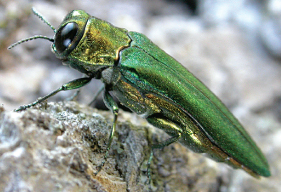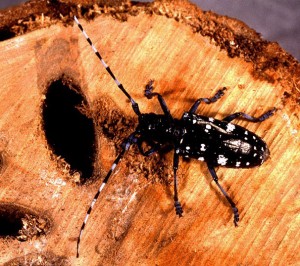Inside The New York Botanical Garden
Asian longhorned beetle
Posted in Learning Experiences on May 24 2013, by Matt Newman
 Notice an arborist with a little extra spring in her step? It’s not surprising. Against all odds, the Asian Longhorned Beetle (ALB) was finally ousted from Manhattan and Staten Island after a near 20-year reign; even New Jersey is claiming victory, putting us on the road to ALB eradication. But even if this loathsome pest is on the outs in the northeast, we’re not out of the woods—figuratively or literally—with the nagging issue of its accomplice, the Emerald Ash Borer (EAB). These invasive bugs don’t mop up their own infestations, much as we’d love it if they did—it takes awareness and action on everyone’s part to save our trees. And I’m talking about millions of trees in the end game.
Notice an arborist with a little extra spring in her step? It’s not surprising. Against all odds, the Asian Longhorned Beetle (ALB) was finally ousted from Manhattan and Staten Island after a near 20-year reign; even New Jersey is claiming victory, putting us on the road to ALB eradication. But even if this loathsome pest is on the outs in the northeast, we’re not out of the woods—figuratively or literally—with the nagging issue of its accomplice, the Emerald Ash Borer (EAB). These invasive bugs don’t mop up their own infestations, much as we’d love it if they did—it takes awareness and action on everyone’s part to save our trees. And I’m talking about millions of trees in the end game.
Since it was first discovered in New York in 2009, the invasive Emerald Ash Borer has killed tens of millions of ash trees, and its appetite is indiscriminate when it comes to variety. That leaves every last one of New York’s hundreds of millions of ash trees at risk—trees that not only define our landscape, but support American industry. And though good fences do make for good neighbors, these six-legged invaders aren’t partial to friendly truisms; it’s up to everyone to cooperate in looking out for New York’s flora at large.
Read More
Posted in Around the Garden, Science on August 1 2012, by Matt Newman
 Asian longhorned beetles (ALB) are many things, but picky eaters isn’t one of them. It’s part of the reason they’re now such persistent pests throughout the northern United States. Worse, they’re approaching something of an outright pestilence. These non-native invaders are mincing maple populations, trashing elms, making a buffet of poplars and will happily bore into a wide menu of other tree genera! But thanks to a partnership with the Sentinel Plant Network, a USDA-funded collaboration between North American public gardens and other concerned groups, the NYBG is proud to serve as one of a number of “watchposts” striving to counter the menace through safe, effective means. That’s where our bug traps come in.
Asian longhorned beetles (ALB) are many things, but picky eaters isn’t one of them. It’s part of the reason they’re now such persistent pests throughout the northern United States. Worse, they’re approaching something of an outright pestilence. These non-native invaders are mincing maple populations, trashing elms, making a buffet of poplars and will happily bore into a wide menu of other tree genera! But thanks to a partnership with the Sentinel Plant Network, a USDA-funded collaboration between North American public gardens and other concerned groups, the NYBG is proud to serve as one of a number of “watchposts” striving to counter the menace through safe, effective means. That’s where our bug traps come in.
Native to Japan, China, and Korea, Anoplophora glabripennis first made its U.S. presence known in 1996. Soon after, it was found in Canada, France, Italy, Germany, and a slew of other countries less than welcoming of their newest guests. By the time authorities concluded that hardwood shipping crates were to blame, it was too late to shut the door: the beetles were already reproducing, boring into trees to lay their eggs. Upon hatching, the larvae then ravage the trees further, feasting on bark and inner wood. And 16 years later, the hunt continues for a fool-proof means of eradicating the ALB from American forests.
Read More
 Notice an arborist with a little extra spring in her step? It’s not surprising. Against all odds, the Asian Longhorned Beetle (ALB) was finally ousted from Manhattan and Staten Island after a near 20-year reign; even New Jersey is claiming victory, putting us on the road to ALB eradication. But even if this loathsome pest is on the outs in the northeast, we’re not out of the woods—figuratively or literally—with the nagging issue of its accomplice, the Emerald Ash Borer (EAB). These invasive bugs don’t mop up their own infestations, much as we’d love it if they did—it takes awareness and action on everyone’s part to save our trees. And I’m talking about millions of trees in the end game.
Notice an arborist with a little extra spring in her step? It’s not surprising. Against all odds, the Asian Longhorned Beetle (ALB) was finally ousted from Manhattan and Staten Island after a near 20-year reign; even New Jersey is claiming victory, putting us on the road to ALB eradication. But even if this loathsome pest is on the outs in the northeast, we’re not out of the woods—figuratively or literally—with the nagging issue of its accomplice, the Emerald Ash Borer (EAB). These invasive bugs don’t mop up their own infestations, much as we’d love it if they did—it takes awareness and action on everyone’s part to save our trees. And I’m talking about millions of trees in the end game.
